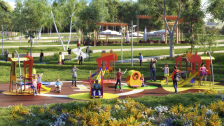Managing risk in play provision
The Play Safety Forum has produced an important document which helps those involved in children playground of any kind offer stimulating, challenging environments to develop and explore their abilities in a safe way.
Aiming to manage the levels of risk so that children aged 0 to 18 are not exposed to unacceptable risks of death or serious injury, this document is dedicated to a wide range of organisations and institutions:
- play areas
- outdoor and indoor playgrounds
- adventure playgrounds
- play centres
- holiday play schemes
- playground equipment manufacturers and inspection agencies
- childcare provision
- schools
- parks
- public open spaces
- those involved in insurance and litigation in relation to play provision.
In order to
minimise the risk of injuries whilst allowing the children to
enjoy a healthy range of play opportunities that encourage their development, the
Play Safety Forum recommends the following:
- Determine if the level of risk is acceptable
Run a playground risk assessment of each activity to understand the balance between risks and benefits. Take into consideration that even if sometimes there is a risk of fatal or very serious injury like in paddling at the seaside, this risk may be tolerable because in most circumstances the likelihood of coming to harm is very low and there are obvious benefits.
- Have clear policies and procedures in place
The key to good practice in playground risk management is to have policies that state clearly the overall objectives and procedures that are giving guidance on how these policies are put into practice. At the same time, the procedures should also emphasise the importance of professional judgement in setting the balance between the playground safety and other goals.
- Pay attention to the social and psychological factors
Your policies should also take into account that risks that are tolerable in one community might be unacceptable in others.
- Have in place measures for justified hazards
If you have sources of harm that are impossible or too costly to remove or their removal would have undesirable consequences, put in place measures to manage them. As a controlled environment, you are legally responsible to identify and make informed judgements about the hazards to which people are exposed.
- Provide controlled opportunities for children to manage risk
The exposure to the risk of injury and even the experience of a minor accident give children the opportunity to gain direct experience of the consequences of their actions and choices allowing them to understand both their abilities and limits. However, always take into consideration that children do need a greater protection against fatal or serious injuries.
- Keep a balance between offering risk and keeping children safe
Because exposure to some risk is actually a benefit for children, in kids playground it’s acceptable that they may be exposed to minor injuries as bruises, grazes or sprains. However, you should not expose children to significantly likelihood of permanent disability or life-threatening injuries.
- Strike a balance between the playground risk and benefits
Crucially, your playground risk assessment should involve a risk-benefit trade-off between safety and other goals, which should be spelt out in your policies. Make sure your play provision is challenging enough to keep children away from satisfying their appetite for risk-taking in environments that are not controlled or designed for them.
- Make the risk as apparent as possible for children
Your spaces should be design in such way that children can easily appreciate the risk of injury that arises from hazards (for example heights). Hazards that children may not appreciate should be absent (for example equipment that can trap heads). This applies to all play provisions, but especially to those unsupervised.
In conclusion, even though your play provision must be safe for children, you have to remember the space is actually dedicated for their enjoyment and benefit. In order to keep a balance between the safety and level of risk your playground is providing, you should take into consideration that:
- you will need to reach compromises that are a matter of judgement and not of mechanistic assessments
- the judgements should be based on both social attitudes and on broadly-based expert opinion informed by current good practice
- the judgements should be firmly rooted in objectives concerned with children’s enjoyment and benefit
- the judgements should take into account the concerns of parents
- the judgements should be made clear in the policies of the play provider as written down in policy documents
- the policies should in turn be understood and embodied in practice by all the key stakeholders.
If you have any questions regarding managing risk in children playground or if you are involved in an injury case, please do not hesitate to contact our Expert Witnesses on 0117 986 2194 or at enquiries@iew.org.uk.
Back to News
